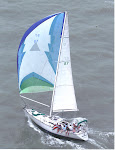


 White Pepper
White Pepper is idled with transmission problems. While waiting out the weeks for the transmission to be rebuilt Jan and I decided to make lemonade out of lemons and tour NE North Carolina by rental car. First we were are to drive back to Virginia and visit the children, Layla and Kristi, in northern Virginia. They call it NOVA. We had a wonderful visit, and I got to meet my first grand puppy, Jawa, a sweet Newfoundland mix pup.
After the visit we headed back south. We crossed Hampton Roads on the new tunnel-bridge and saw with mixed emotions the great row of cranes that line the Norfolk Reach. We had only sailed past them last month and did not expect to see them again for many months. We flew over the ICW on I-64W looking down at the small creek off of the South Fork of the Elizabeth River that marks the beginning of the Dismal Swamp route. Of interest this bridge opens rarely for very large ship traffic. About 30 minutes after we crossed over the bridge opened and then was stuck open for 4 hours. Traffic was snarled all over Norfolk all afternoon and night.
We passed Coinjack, the town that marks where the Chesapeake and Albemarle canal enter Pamlico sound. Then our trusty rental car took us over Currituck Sound onto the barrier islands of the Outer Banks. The first town is Kitty Hawk. Kitty Hawk is congested and reminds me of the nicer and newer parts of Galveston. Kitty Hawk does and always will have the Wright brothers. The First in Flight National Park is now in a new town, Kill Devil Hills, just south of Kitty Hawk. It is well worth a visit. I was amazed at how short the first flight was--159 feet. It lasted 14 seconds. I walked the actually distance in 22 seconds. That was in 1903. It is sobering to consider that only 15 years latter sophisticated planes were warring over the battlefields of WWI.
We spent the night at a quaint inn in Manteo, NC on Roanoke Island. Alert readers will remember that Roanoke Island was the site of the first English colony in the new world. Virgina Dare was the first English child born in the new world about 1587. When the supply boat returned about 1590 the colony and Virgina had vanished without a trace. Its fate is a mystery to this day. The next English try was at Jamestown, VA. They did a little better, if only barely. Manteo has a well developed waterfront as well as a high density, upscale shopping district. It looks like Rodeo Drive in miniature. Maneo and the Roanoke Sound is an eastern alternative to the Alligator and Pungo River route. We may try it on the way north next year.
The national seashore starts just south of Maneo and stretches 40 quite thin miles to Hatteras. It is a spectacular drive. Although reminiscent of Mustang Island and South Padre Islands, it is narrowed. Pamlico Sound on the west is quite large, much more so than the Laguna Madre. The day we drove it was cold overcast and blustery which was great since the Atlantic on our east put on quite a show of great breaking waves. At one point in the town of Rodanthe the waves were washing over the road.
We watched in amazement as hugh breakers rolled across the Oregon Inlet. I may try to sail through the inlet someday but never on a day like that. We only drove as far as Hatteras which looks like a tattered version of Port Aransas. To be fair it is quite isolated and took a severe beating from Hurricane Isabelle several years ago. There are more barrier islands to the south. Some can only be visited by boat. Eventually the island chain rejoins the mainland at Cape Lookout near Morehead City, NC.
But the reason people make this trip is the lighthouses. We stopped at the Bodie Island Lighthouse which is undergoing extensive reconstruction. The high light of the day, however, was the Hatteras Lighthouse. It is a majestic structure as well as a true American icon. Unbelievably it was recently moved 1200 feet back from the beach where erosion threatened to topple it. Also the actual Cape Hatteras has migrated several miles to the south. Proper navigation nowadays uses the Diamond Shoal light tower many miles off shore. The lighthouse was closed for the season so we could not climb it. Pictures would have to do.
We decided to skip the ferry ride across Pamlico sound since it was getting late and dark with the season. The state of North Carolina maintains a vigorous ferry service to various ports in the Pamlico South and across Hatteras Inlet. The drive back to the boat took up across the Alligator River Bridge and through the desolation of the Alligator Game Preserve. This was the scene of much worry sail south a month previously. We reminisced about celebrating my birthday in the Alligator River Marina only 3 weeks previously. Hopefully, I will never see that place again.









